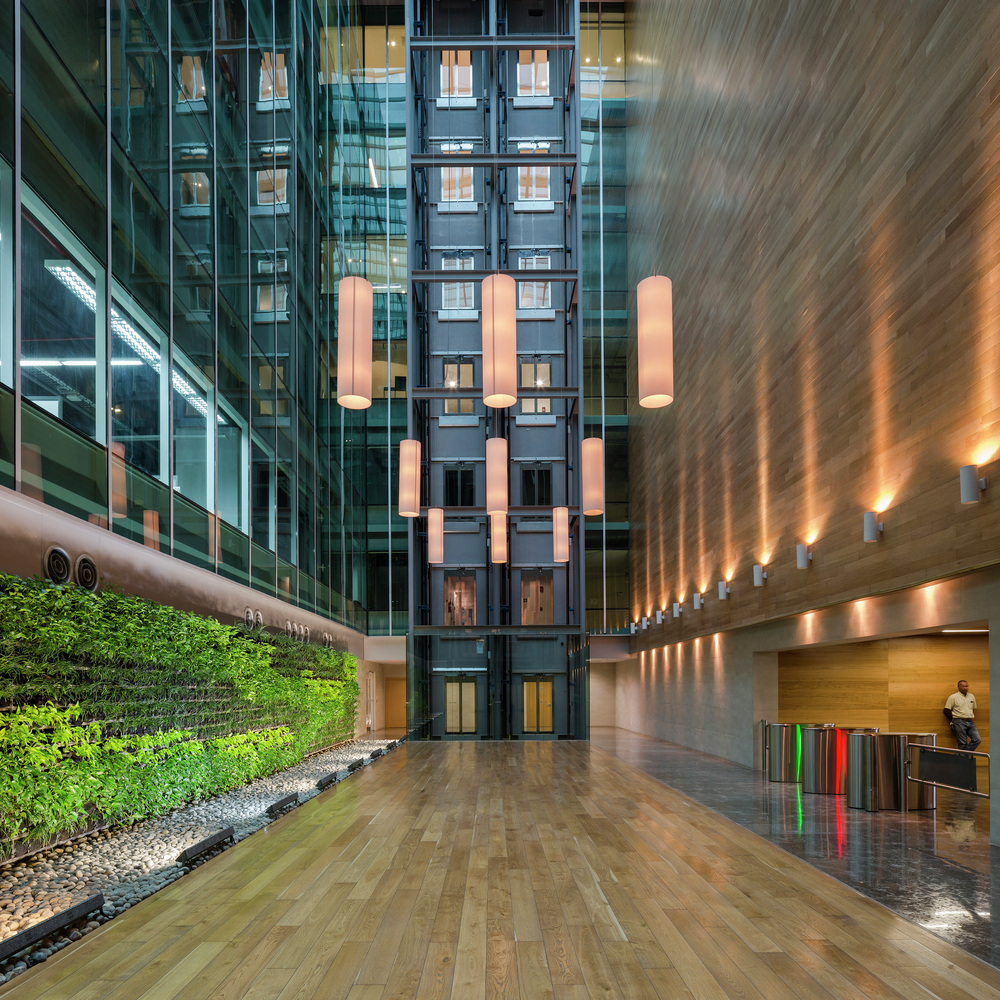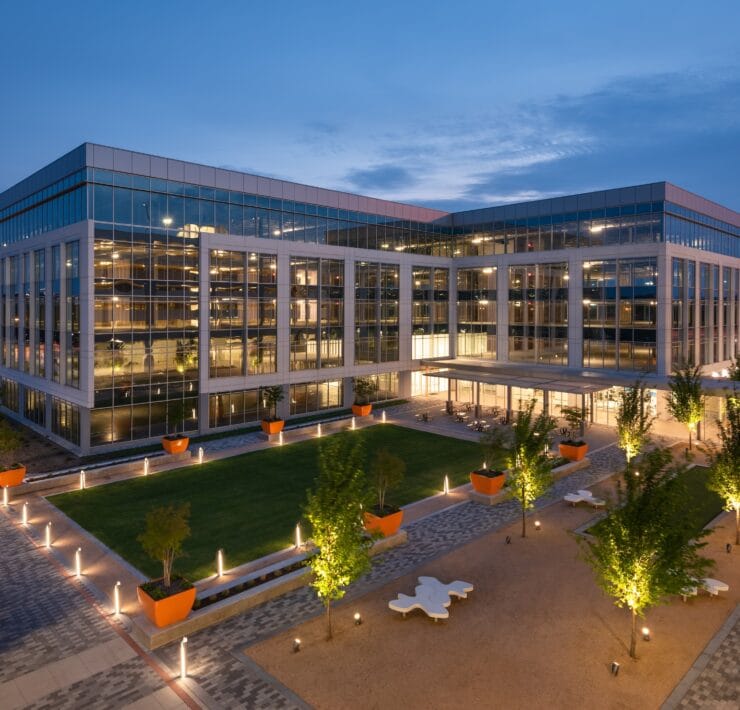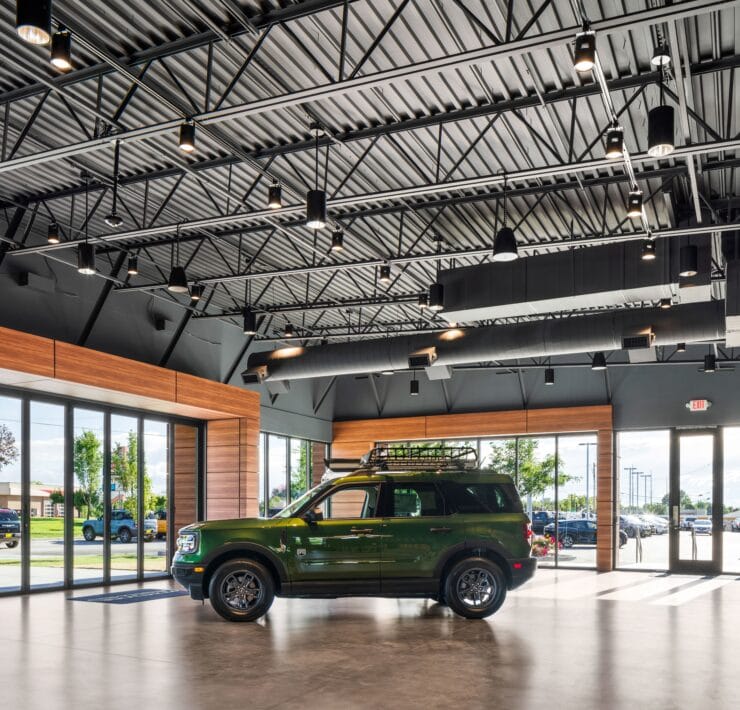Gary R. Flamm is an energy consultant and former lighting lead at the California Energy Commission. He has over 30 years of experience in the industry and specializes in guiding stakeholders through the nitty gritty of Title 24 compliance. You can find Part 1 of the interview here.
Do you have any advice for lighting designers or electrical engineers on how to make applying the code as painless as possible?

© Fernando Alda
Don’t approach it with fear. Don’t over-design. Use light surfaces wherever possible.
The LPDs [lighting power densities] are developed by making prototypical designs to meet IES recommendations, whether it’s retail, or a warehouse, or an office—whatever the needs are—and then reverse engineering a power density from that using efficient light sources.
And so the fear that you’re not going to be able to do a design is not really founded—because you can do a design according to IES recommendations within the context of [the] budget given by the code. However, if somebody has a personal preference that exceeds the recommended design levels, they’re not going to be able to do that.
So, [I want] to dispel the fear that you’re not going to be able to have enough power—that’s not correct, because that’s not how the code is developed.
Not to over-design. To use light surfaces. Don’t expect to have a room [with] entirely dark surfaces and get enough light. You need to think of your room as your luminaire. And so you’ve got all this bouncing [of light] going around in the room. If you want some color, you make that on the lower part of the room to give the upper part of the room more reflectivity.
Don’t approach it with fear. Don’t over-design. Use light surfaces wherever possible.
LED Linear Suspension Lighting.
Do you have any advice on understanding the code for someone who doesn’t read code or doesn’t come from this kind of background—any advice on how to understand it better?
So, it isn’t that the code is complex—understanding the code is complex.
I don’t. I was involved for 30 years in this and I also [don’t] understand the code. The code is a legal document, and there’s a certain construct to that legal document that isn’t easy for the uninitiated to understand.
So, it isn’t that the code is complex—understanding the code is complex. And that’s why the energy commission writes the compliance manual, which basically pulls all of the different segments of the code into subject matter chapter[s].
If you’re going to try to read the legal language and you don’t understand how all the pieces fit together, you will probably be overwhelmed. But there’s a number of documents: there are the compliance manuals, the electric utility companies are always putting on classes—”How does this work?” Attend those classes, read the manuals, call the hotline at the energy commission when you’re confused. That’s probably it.
There are a lot of efforts to help educate people. Myself personally, I have a number of clients whom I teach. You either need to hire somebody who knows what they’re doing. Or you need to educate yourself. I’m not trying to be cold or anything—but it is true that the code is hard to read if you don’t understand how the pieces fit together.
Did you ever get any hate mail when you were working for the energy commission?
And there were people that were livid when they called me, and we were about ready to go have a beer when they were done.
I never took it defensively, because I understand. I never got defensive and I was never dogmatic. I listened to people. And I talked to them. And there were people that were livid when they called me, and we were about ready to go have a beer when they were done.
Because I seem to have a skill of—”Okay, let’s relax and talk about this.”
A lot of people would call because they would wanted a variance. They didn’t understand it, they thought [the requirements] were stupid, they thought they were expensive, they didn’t want to do it, and they would call ready to fight, saying “I’m going to tell you the reasons I don’t have to do this.”
And I would tell them, “Nobody, especially me, but nobody has the authority to give you a variance. Okay, now let’s talk about ‘what it is’ and ‘why it is,’ we can talk about that.” So usually when you gave people time and you tried to explain to them the “why,” then the “what” became secondary. Most people became satisfied with the “what.”
So usually when you gave people time and you tried to explain to them the “why,” then the “what” became secondary.
So, I actually invited—whenever other staff couldn’t deal with a troubled stakeholder, I’d say, “Send them to me, I’ll talk to them.” Most of it was because of fear and misunderstanding. That’s what most of the angst was.
You talked in another interview about protecting the visual experience, could you talk more about that?
So, I think it’s very critical that people who are concerned with lighting quality make sure that the code doesn’t steal the visual experience from us.
I had a degree in music, and I was a starving musician 32 years ago when I got into this field. I’ve always been sensitive to the arts [and] to the visual experience that we all have.
There are a number of stakeholders who get involved in the rule-making process and all of them have an interest. It’s not a moral issue, they just have an interest. No interest is irrelevant—whether it’s save money, sell more products, or energy efficiency goals. And everybody’s interest is not sensitive to the visual experience.
To some people, it’s kW savings period, nothing else matters. To them, lighting quality is just horizontal foot candles, there’s no consideration for textures and contrast and spectral content. And so the reason I talk about the visual experience is there needs to be a balance of stakeholders providing input to the code. Because if they’re not, all interests may not be considered. It’s not that the code writers are insensitive, it’s that the focus might not be on lighting quality.
To some people, it’s kW savings period, nothing else matters. To them, lighting quality is just horizontal foot candles.
So, I think it’s very critical that people who are concerned with lighting quality make sure that the code doesn’t steal the visual experience from us. Granted, 200 years ago the visual experience indoors was not good. But now it is—now that we stay up until 2AM in the morning and now that we have spaces that function after dark. We don’t want those spaces to be devoid of the visual experience.
The incandescent bulb is more a heater than it is an illuminator. Because 95% of the energy gives heat and lighting is just kind of an incidental—yeah, by the way this heater puts out a little bit of light.
Even manufacturers—let’s say for example metal halide technology is losing market share to LED. Even incandescent lamps [are going away] with the new codes—by 2020 the federal code says 45 lumens/watt. That’s going away.
Now that may not be a bad thing. The incandescent bulb is more a heater than it is an illuminator. Because 95% of the energy gives heat and lighting is just kind of an incidental—yeah, by the way this heater puts out a little bit of light. So societally, it may be good that we move on. It was wonderful while it lasted, but we buy new computers every two years and we have a lighting technology that’s 150 years old.
What are we going to do with that? Are we going to go with compact fluorescents that get down below $1 but they flicker and they sputter and they spark and they make you look like your skin is dead, or are we going to favor high color rendering products? Not just efficient, but good color. Good shielding, lack of glare.
When you have something like utility rebates that are the only thing driving the technology, chances are, first cost and then high efficacy are going to be the drivers over quality. A lot of purchases are made because of cost. And cost can be contrary to quality.
What are we going to do with that? Are we going to go with compact fluorescents that get down below $1 but they flicker and they sputter and they spark and they make you look like your skin is dead, or are we going to favor high color rendering products?
That’s why I believe that quality standards are important.
Let’s take the CFL. So many millions of dollars were poured into transforming the market and people still hated them. So, if we surrender efficacy, a little bit of efficacy, not all, [and] if we make quality primary, efficacy secondary, and 90% of people love them—then the total electric load is substantially decreased.
Because people love them. People buy them because they love them. You know, a new iPhone comes out and people wait in line. People will buy something they like. And people never liked compact fluorescents because they were poor quality.
Do you think that LEDs will be the iPhones of the light bulb world?
I always use the idea that my generation likes Norman Rockwell. And the current generation, generation X, or whatever you call them, they like the Starship Enterprise. So this kind of incandescent, warm, fireplace look was treasured by my generation. And the LED bulb is probably going to be highly embraced by the current generation.
You know, a new iPhone comes out and people wait in line. People will buy something they like. And people never liked compact fluorescents because they were poor quality.
There’s a California quality LED lamp standard that I had the privilege of working on and it’s basically trying to say energy codes are a floor but we need something higher than a floor for quality. And so there are some quality standards—not mandatory [ones]—but without influence on the market, the LEDs could go the same way the CFLs went: low cost, high efficacy.
But we’re at a point where if we resist that, we actually could have a new bulb that everybody loves because it’s quality.
For a more simplified take on Title 24, check out this handy guide that breaks down the requirements by area type.
[This interview has been edited and condensed for clarity.]






